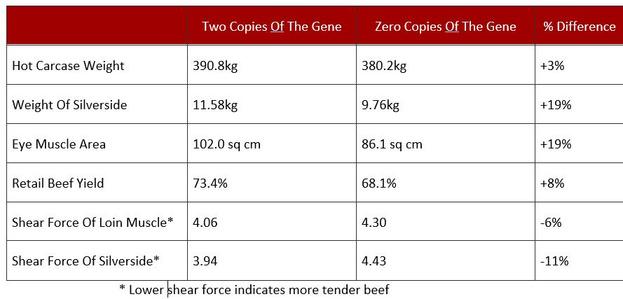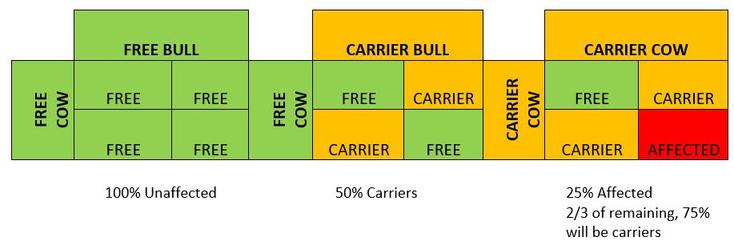
2 minute read
AUSTRALIAN LIMOUSIN BREEDERS SINGLE GENES
C313Y, E226X, NT821 & Q204X are all mutations that make up the myostatin gene.
F94L – Free (CC) No copies
Advertisement
F94L – Carrier (AC) 1 copy
F94L – Affected (AA) 2 copies
What happens when carriers are mated to other animals?

A carrier will, on average, pass the undesirable gene form to a random half (50 %) of their progeny. When a carrier bull and carrier cow are mated:
- There is a 25% chance that the progeny produced will have two normal genes and so will never pass on the undesirable gene.
- There is a 50% chance that the mating will produce a carrier.
- There is a 25% chance that the progeny will inherit two copies of the undesirable gene and hence be affected by the genetic condition.
When a carrier animal is mated to an animal tested free of the genetic condition:
- All progeny will appear normal and will be unaffected by the condition.
- There is a 50% chance that the mating will produce a carrier.
- There is a 50% chance that the progeny produced will have two normal genes and so will never pass on the undesirable gene.
Australian Limousin Breeders Single Genes
Note that an animal that is tested free by a DNA test of the genetic condition will not pass the genetic condition to its descendants, even if it has carriers in its own ancestry Therefore, DNA-tested free animals can be used in your breeding program with confidence that they are not transmitting the unfavourable gene to subsequent generations
Tenderness – MVP TND
An increase in “tenderness” is associated with favourable alleles seen within the selected marker panel. The combined genotype results have been scored between 1 to 10, where 10 has the most favourable number of alleles present.
Suffixes to Animal Names
Horn Status:
PP - Homozygous Polled
P - Polled
Ps - Polled with Scurs
H - Horned
Colour:
BB - Homozygous Black
B - Black
R - Red
A - Apricot
O - Other
Myostatin:
AA - 2 copies
AC - 1 copy
CC - No copies
U - Status Unknown
Most characteristics of cattle such as growth and fertility are controlled by many or multiple genes. Some characteristics such as polledness, colour and protoporphyria are controlled by a single pair of genes.
Actual results are based on DNA samples provided by breeders. Australian Limousin Breeders Society makes no statements, representations or warranties about the accuracy or completeness of any information relating to the status of a particular animal, and disclaims all responsibility for information and all liability (including without limitation, liability in negligence) for all expenses, losses, damages, and costs you may incur as a result of information being inaccurate or incomplete in any way for any reason.
Actual results are only displayed for animals that have been DNA tested for a particular gene or in circumstances where sufficient DNA testing has been conducted on animals within the pedigree to make some assertions as to genetic condition status. In cases where the genetic condition status of an animal is unknown, no genetic condition status will display for the animal.









